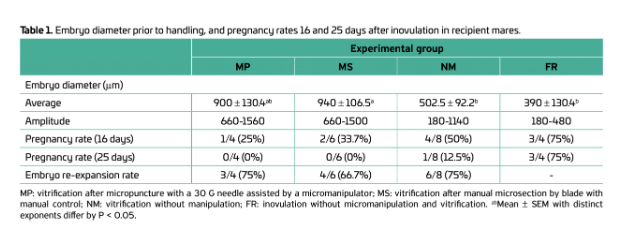Manual collapse of blastocoels in not effective in increasing the viability of vitrified equine embryos
DOI:
https://doi.org/10.21708/avb.2022.16.1.10311Resumo
Embryo cryopreservation methods have been used for commercialization and formation of genetic banks. Cryopreservation of equine embryos <300 µm in diameter, collected at days 6-6.5 after ovulation, allows satisfactory pregnancy rates. However, higher embryo collection rates in mares are obtained when uterine flush is performed between days 7 and 8 after ovulation when embryos are >300 µm in diameter, needing blastocoel collapse for satisfactory resistance to cryopreservation by vitrification. To evaluate the viability of simplified blastocoel collapse by embryo puncture with low technology and low-cost equipment, 22 embryos, collected at day 8 post-ovulation (D8), were allocated to the following groups: (1) micropuncture with a 30 G needle, assisted by a mechanical micromanipulator, before vitrification (n=4); (2) manual blade microsection before vitrification (n=6); (3) no manipulation prior to vitrification (n=8); and (4) freshly inovulated embryos (n=4). Despite the high re-expansion rates observed after vitrification, embryos manipulated prior to vitrification (groups MP and MS) did not result in pregnancy 25 days after transfer. On the other hand, embryos from groups NM (non-micromanipulated) and FR (freshly inovulated) resulted in pregnancies at 25 days. Under the conditions of the present study, manual blastocoel collapse was not efficient in increasing cryotolerance to vitrification among large embryos, requiring improvements to obtain pregnancies.
Downloads

Downloads
Publicado
Edição
Seção
Licença
Autores que publicam na Acta Veterinaria Brasilica concordam com os seguintes termos: a) Autores mantém os direitos autorais e concedem à revista o direito de primeira publicação, com o trabalho simultaneamente licenciado sob a Licença Creative Commons Attribution que permite o compartilhamento do trabalho com reconhecimento da autoria e publicação inicial nesta revista. b) Autores têm autorização para assumir contratos adicionais separadamente, para distribuição não-exclusiva da versão do trabalho publicada nesta revista (ex.: publicar em repositório institucional ou como capítulo de livro), com reconhecimento de autoria e publicação inicial nesta revista. c) Autores têm permissão e são estimulados a publicar e distribuir seu trabalho online (ex.: em repositórios institucionais ou na sua página pessoal) a qualquer ponto antes ou durante o processo editorial, já que isso pode gerar alterações produtivas, bem como aumentar o impacto e a citação do trabalho publicado (Veja O Efeito do Acesso Livre).


 Esta obra está licenciada com uma Licença
Esta obra está licenciada com uma Licença 